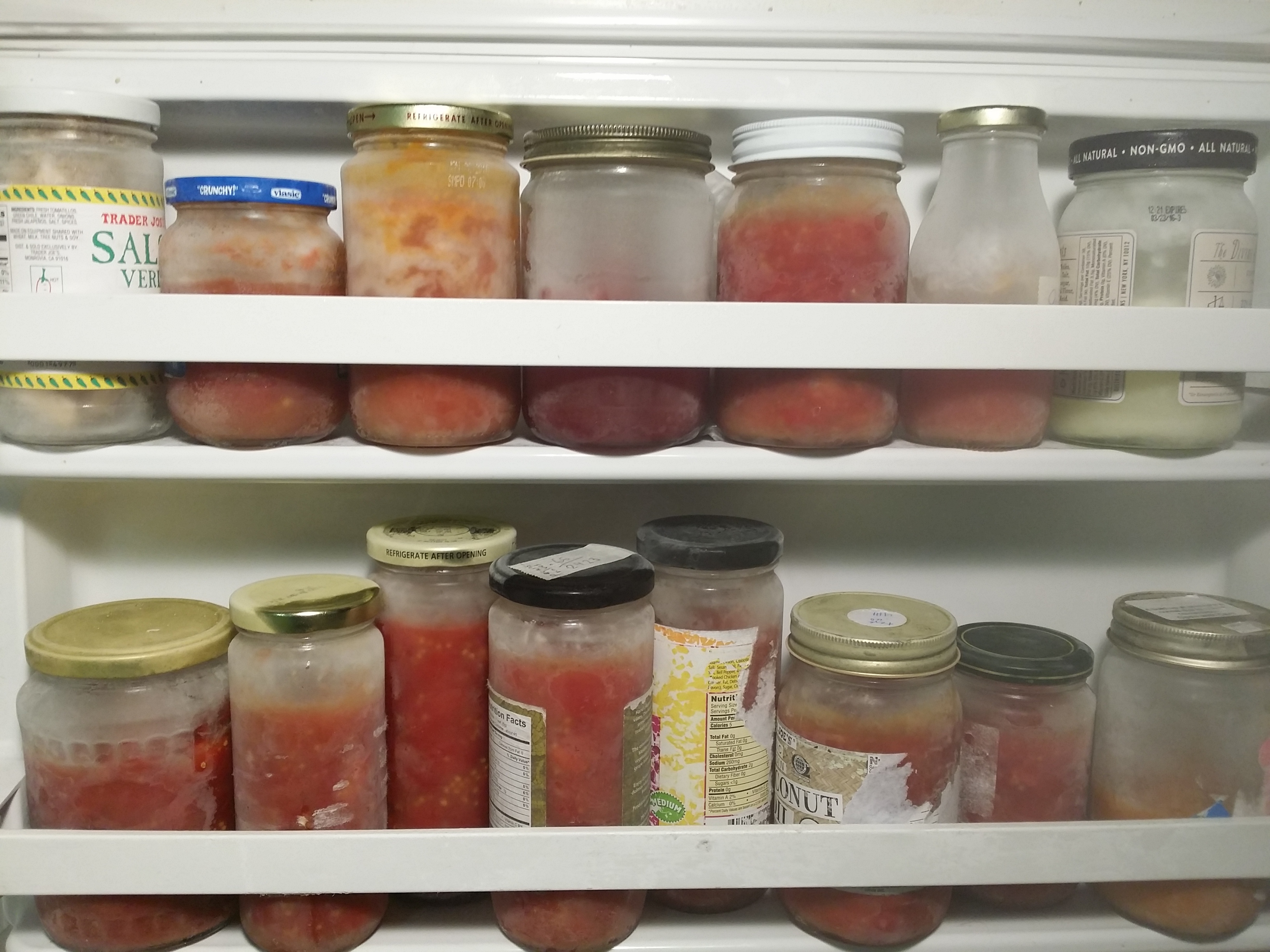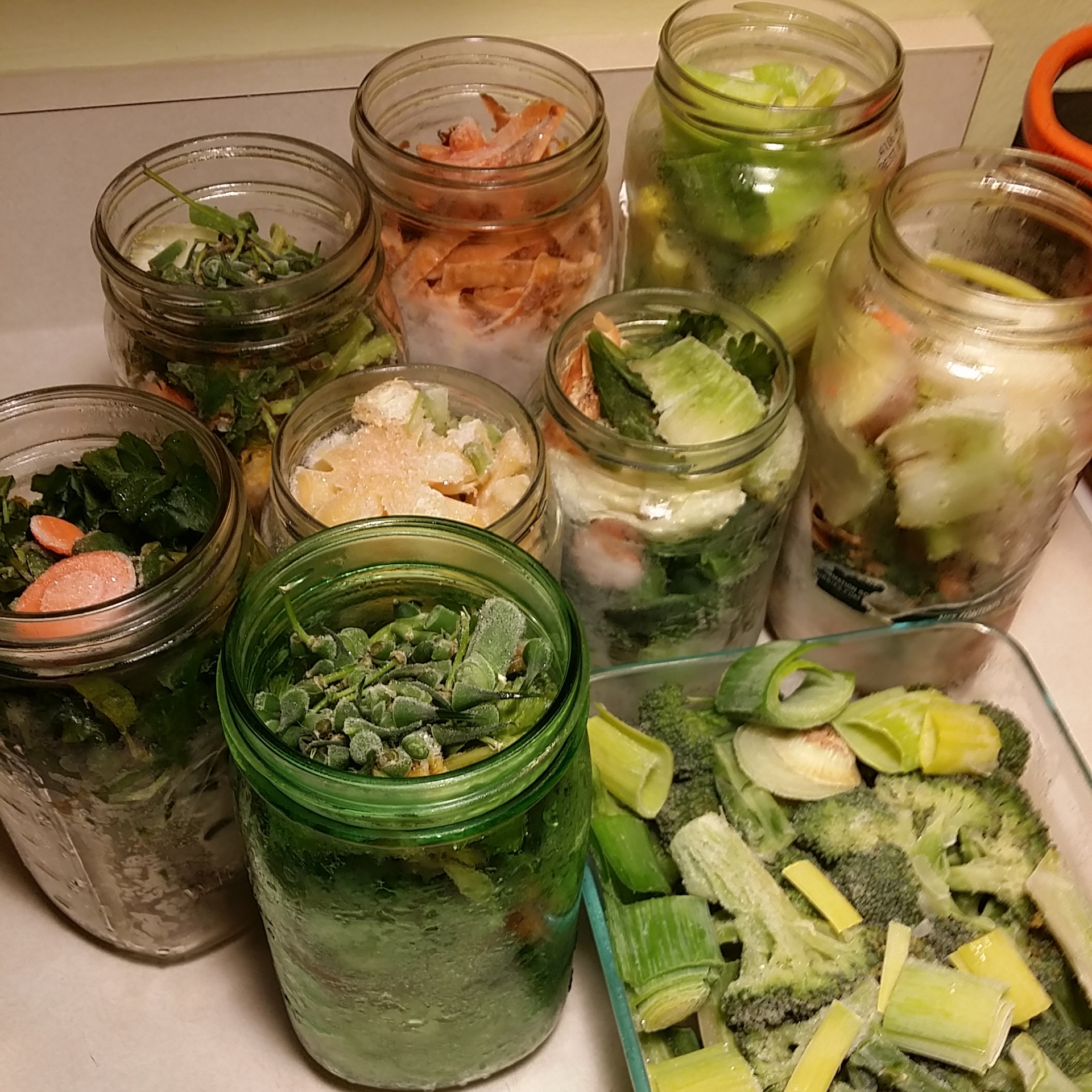Can you cut 1 Tonne of carbon pollution out of your life?
Take the challengeThis is a guest article by
When I post pictures of my jar-filled freezer on social media, I get lots of questions about it, usually along the following lines:
- Is it safe to freeze food in glass? (Yes)
- Do you use special glass for the freezer? (No)
- Don't your glass containers break? (Only that one time…)
I have had little trouble freezing food in glass. I do however take a couple of precautions:
Always leave headspace when freezing liquids. I prefer wide-mouth jars for freezing or at least jars without shoulders (i.e., straight sides all the way up to the top). I have broken only one glass container in the freezer—it's one of those things you do only once. I filled a narrow-neck milk bottle with liquid (likely broth, I forget exactly). Even though I had left head space, when the liquid froze, it expanded and snapped the narrow neck cleanly off the (very nice) bottle. Oops.
Occasionally I'll use pyrex round or rectangular containers with plastic lids, which I bought before I went plastic-free. I don't use these very often in the freezer because I like to keep the glass portion of them free for roasting food.
Don't overstuff your freezer with jars stacked all over the place willy-nilly. When you open your freezer door, jars might fall out onto the floor and break.
What I Freeze
Beans. Depending on the recipe I plan on using the beans in, I freeze these with or without liquid. I love having cooked beans on hand in the freezer. I make channa masala or hummus with chickpeas, a spicy bean dish with black beans and refried beans with pinto beans. I dislike the texture and taste of canned beans, not to mention the BPA (or an equally nasty equivalent) present in the plastic lining of canned food.

Sourdough crackers. These freeze very well! They taste so delicious, they never stay in the freezer long though. (Click here for the sourdough cracker recipe.)
Cookies. I don't make cookies very often because I have little will power around sweets. But when I do bake them, I'll freeze some in a large wide-mouth jar.
Bread. If I bake several loaves of sourdough bread, I'll freeze a loaf or two half loaves in homemade cloth produce and bulk bags.
Fruit. I don't buy frozen fruit because it's always packaged in plastic bags. Instead, I freeze seasonal fruit: berries, peach slices and grapes. I spread these out on a cookie sheet and put that in the freezer. Once the fruit has frozen, I transfer it to glass jars.

Fruit peels and cores.
The first time I made scrap vinegar, I used apple peels and cores I had frozen until I had accumulated enough of them to make vinegar. The microbes necessary for the fermentation survived the freezer and the vinegar turned out well.
(Click here for the scrap vinegar recipe.)
Lemon zest. Yes, you can freeze this! I have a small glass jar of it in the freezer now.
Roasted tomatoes. Throughout the summer, I buy lots of dry-farmed early girl tomatoes at the farmer's market. I halve or quarter these into bite-size pieces, roast them at about 225°F for an hour and a half or two and then freeze them in jars. They taste delicious, especially with the chickpeas above for channa masala. So good! (Click here for the roasted tomatoes recipe.)

Leftover whey. Making ricotta cheese produces an alarming amount of whey. I freeze this in ice-cube trays and then transfer the frozen cubes to glass jars. A few cubes of whey adds some nice tang to soup. (Click here for the ricotta recipe.)
Chicken bones. We don't eat much poultry or meat but when we do I always save the bones for broth. Once I have enough, I simmer water and the bones in my slow cooker for twenty-four hours. (Click here for the bone broth recipe.)
Vegetable peels and scraps. I save the ends of carrots, celery, onions, green beans—pretty much all the vegetables I prep, with the exception of bitter greens like chard—and store them in glass jars in the freezer. When I have accumulated a large pile of scraps, I simmer them in water to make broth. I then strain that and either use it immediately or freeze it. I like to use ice-cube trays to freeze broth but sometimes I'll just freeze it in a jar—with headspace!
(Click here for the vegetable broth recipe.)
Soup. I love to make a vat of soup and freeze some of it in jars for meals later on in the month. (Click here for the rescue soup recipe.)
Tomato sauce. I have only one small jar of this in my freezer now. I can fit only so much in there… (Click here for the tomato sauce recipe.)
I likely have forgotten to mention a few things that I freeze, but this gives you a good idea of what you can freeze without plastic—all sorts of good food!
Anne Marie Bonneau writes the blog The Zero-Waste Chef. She runs her kitchen following three simple rules: no packaging; nothing processed; no waste. Anne Marie lives in Northern California, where she teaches fermentation workshops, speaks on zero-waste and plastic-free living and hosts webinars on these topics. You can follow her on Facebook, Instagram and Twitter at @ZeroWasteChef.
Check out the author's website here
Images: Supplied
READ THIS NEXT: 10 amazing uses for ice cubes
